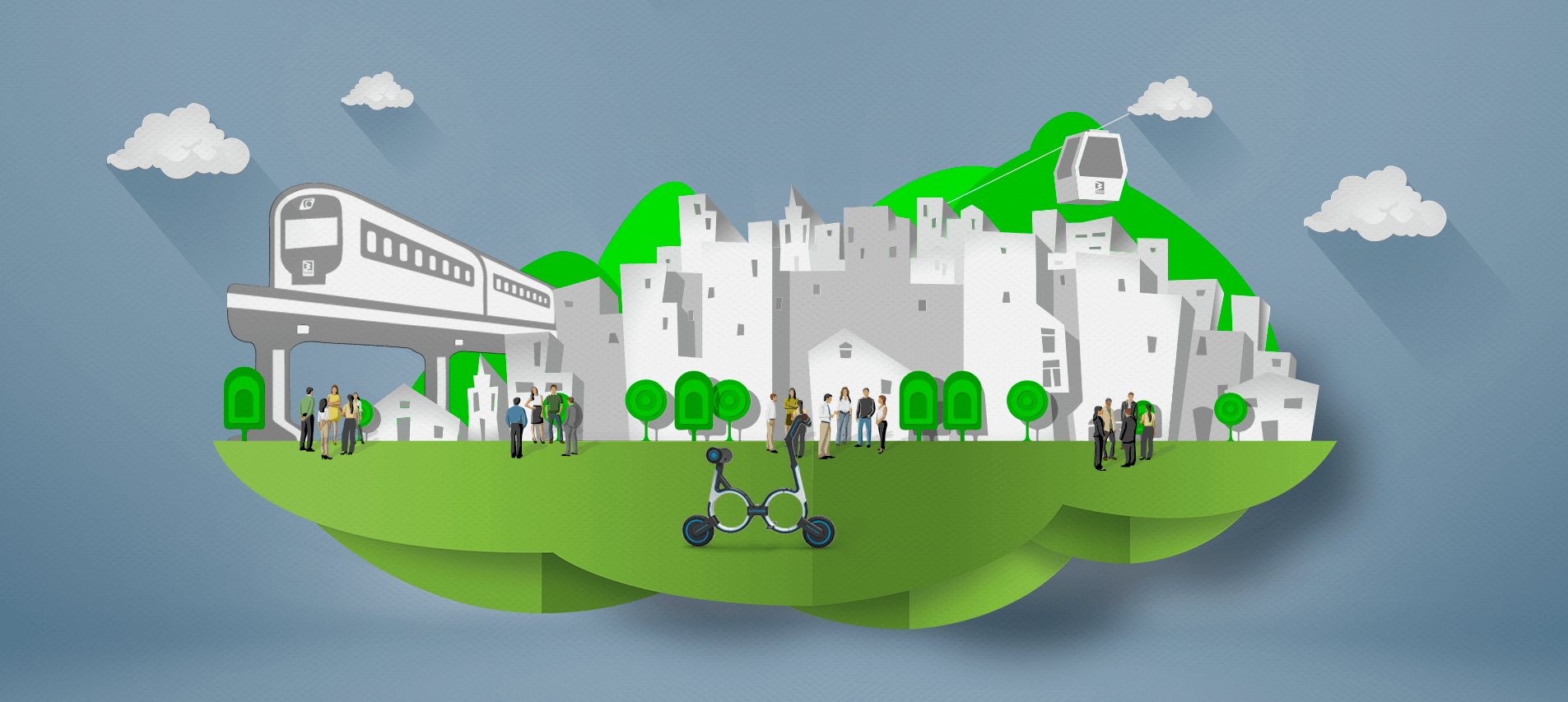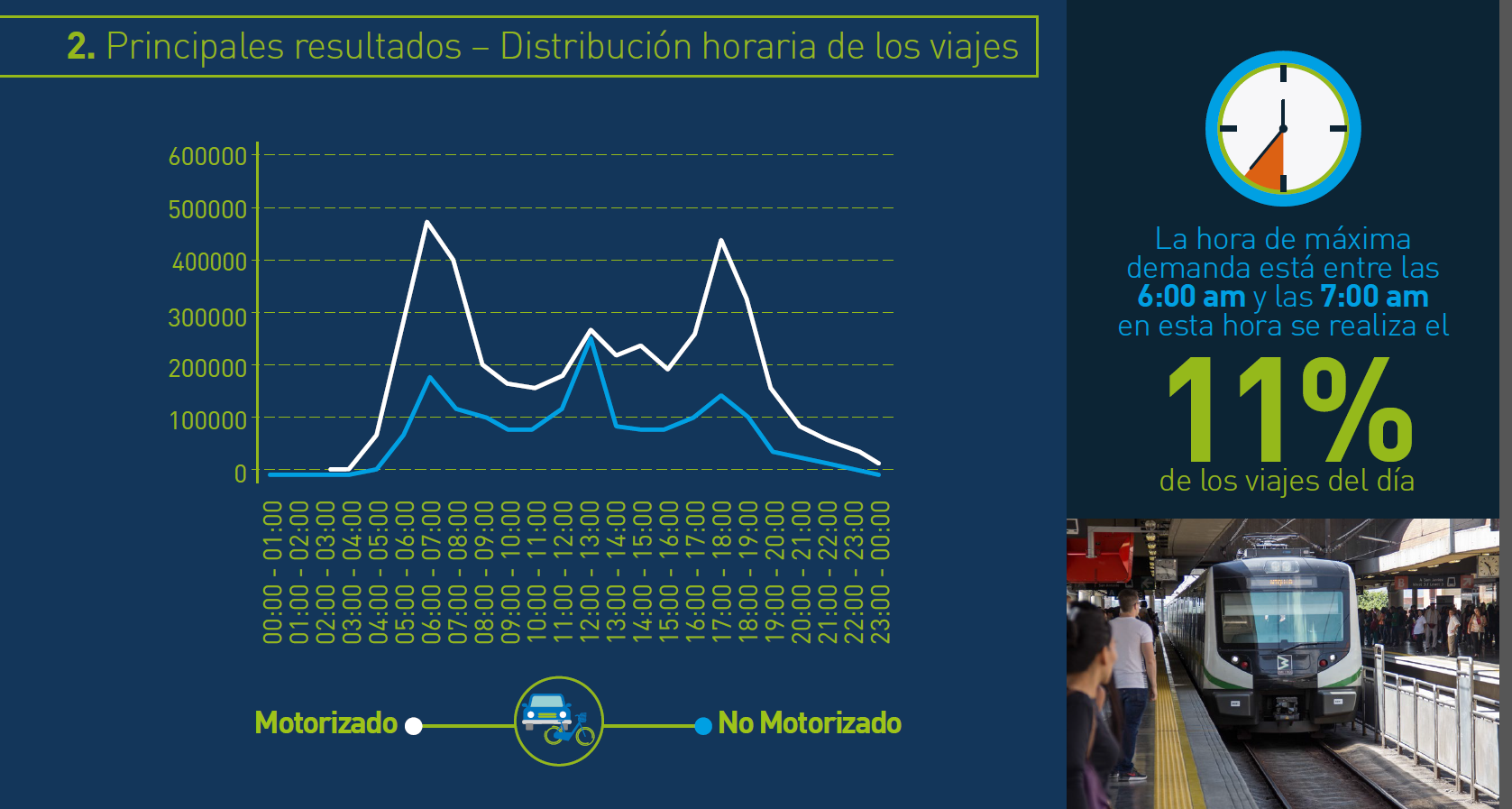
Challenge
Trigger question
How to reduce congestion to access the Metro System?
Current situation
The current conditions of the dynamics of mobility in the city region have a great impact on private and public transportation infrastructures, due to the high travel demands that coincide in the timing of trips, both in the morning and in the afternoon. This can be evidenced in the morning rush hour, between 06:00h and 07:00h, where 11% of the trips of the day are made in the Metropolitan Area of Valle de Aburrá. This generates an insufficient supply of roads for private transport and Collective Public Transport (TPC), as well as a greater concentration of trips with high densities in the Mass Public Transport system, sometimes exceeding its supply capacity to meet the demand.
This makes it necessary to identify and implement actions to modify mobility patterns, especially for those that are considered mandatory (work and study, which represent approximately 64%).

Source: Encuesta origen Destino AMVA
Actions taken by Medellin Metro System:
Interventions in the infrastructure of stations that demand a greater number of trips, expanding their access capacity.
- Expansion of Niquía and Itagüí Stations.
- Extension of Line A (Itagüí to La estrella)
- Poblado station expansion.
- Aguacatala station expansion.
- Station expansion design: Aguacatala, Industriales, north Itagüí, Madera, Caribe, south Envigado, Ayurá.
- Expansion design: north Envigado, Bello, pre-feasibility study for extension of stations line B.
Acquisition of 22 new trains (€380 million) to improve the transport service offer in accordance with the needs of the growing demand. The commercial operation interval was reduced from 4.25 min to 3 min on line A and from 4.75 min to 3.8 min on line B.
With the new rail signaling system, an interval between 3 and 2.5 minutes is achieved, which speeds up the service.
With the help of metro culture personnel, orientation of mobility flows within the stations is carried out.
Proposals made by the Company:
Within the framework of the Metro Culture, understood as a positive way of relating with ourselves, with others and with the environment, we express the importance of changing transportation habits in the Valle de Aburrá, in this order of ideas we have proposed:
Transportation demand management measures
Staggered schedules
Modify schedules in study and work centers in order to generate a better balance in mobility in the territory. However, despite being a public entity, we do not have the power to issue guidelines to other institutions to adopt flexible schedules, nor can we take measures related to the differentiation of fares according to schedules, since this decision lies solely and exclusively with the competent authorities under the provisions of Law 105 of 1993.

Source: Estudio de movilidad del AMVA 2017.
Reduction in the number of work or study days per week
Tested by increasing the daily workday to 10 hours and freeing one day a week from the work center, or to 9 hours, freeing one day for every two weeks, it can reduce commuting by up to 20%, which would significantly alleviate traffic congestion (USDOT 93). Experiments carried out in Denver, Arizona, in 1981, with 9,000 employees of 42 government agencies, reducing the weekly workday to four 10-hour days, resulted in a 15% reduction in employee commuting; a 56-42% decrease in traffic during the half-hour rush hour (47-34% during the outbound rush hour), and all this without the new schedules having any influence on the use of public transportation and carpooling. Another experience in Ventura, California, in 1990, with the introduction of the four-day week, had, among other effects, a reduction from 82 to 77 percent of drivers traveling alone in their vehicles (USDOT, 1999).
Other actions that have been analyzed and, in some cases, have been implemented by the Company, according to its possibilities:
| Area | Short term | Mid-term | Long term |
|
Operations |
|
|
Initiate automatic train controls to improve wagon arrivals |
|
Messaging and signaling |
|
|
Initiate dynamic location-based messaging of trains and transportation systems in real time. |
|
Design of portals and entrances |
Implement signage and messaging strategy |
|
Build additional portals |
|
Vertical Circulation |
Consider unidirectional stairs to maximize bidirectional flow rates. |
Adjust escalator speeds. |
|
| Platforms |
|
|
Expand the platform. |
Source: https://transweb.sjsu.edu/PDFs/research/1230-passenger-flows-in-underground-railways-stations-platform.pdf
Available solutions on the market:
These solutions make it easier for systems to know the status and predict demand in order to devise strategies to facilitate their attention. However, they are insufficient to meet an overflow:
- Passenger counting technologies such as manual counting by number of tickets and origin-destination studies and through APC - Automatic Passenger Counting which comprises the automatic technologies applied to monitor the flow of passengers and loads in the system (Passenger Information, infrared sensors, treadle mats (pedal mats), passive thermal, ToF- Time Of Flight, CCTV, GPS, GSMR- Global System for Mobile Communications).
- Predictive systems of passenger flows, through the modeling and simulation of passenger flows, through the use of specialized software.
- Passenger weighing.
- Some trends for flow measurement are: Infrared for real-time passenger counting and Stereo cameras: real-time passenger flow.
What are we looking for?
Proposals that, as a minimum:
- Involve locally developed elements of Industry 4.0.
- Disruptive proposals.
- Have technical viability.
We would love to hear the idea as well:
- It has not been implemented in the world.
- Promote the development of local industry.
- Present a business model in which the cost benefit is compelling to invest in the solution.
However, and definitely, the idea can NOT:
-To implement changes in the fare defined for the provision of the metro service.
- To be detrimental to public resources.
- Propose actions not contemplated in Colombian law.
Your idea will be analyzed when you present an implementation structure that includes:
- Structured proposal with its general description, detail of functionality, materials, benefits and implementation schedule.
- Business model, including cost-benefit analysis.
Analysis criteria
Technical viability: 40%
Presented at technology maturity level TRL 3 "The activities carried out are strongly research and development, which include analytical studies and laboratory-scale studies to physically validate the predictions of the separate elements of the technology" and at stage SRL 1-3 "reflect the initial work on a research project, which includes suggesting and preliminarily testing a technical or societal solution to a technical or societal problem. Here reflections are made on the general disposition of society towards the idea and the proposed solutions needed, including the identification of relevant stakeholders and how to include them (as end users, appropriate communities, etc.) at SRL level 3" Proof of concept of the proposed solution with a significant sample of relevant stakeholders".
- Financial viability: 40%.
- Measurement indicators after implementation of the idea: 20%.
Expert analysts
- Customer service.
- Strategic planning.
- UEN Civic.
To participate
- Each team member must register, fill out the intellectual property form and accept the terms and conditions.
- Up to three ideas per participant are allowed.
- The information provided must be in Spanish.
- The legal or natural person that submits the solution to the challenge may at no time transfer its participation to a third party.
- This is not a contracting process, therefore, solutions available in the market will not be accepted, nor will it imply any responsibility or contractual obligation between the Company and the applicants.



